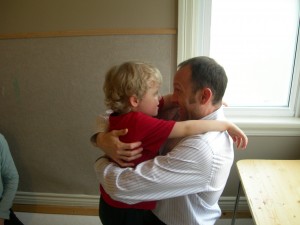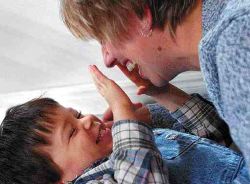If you’re going to teach a child social skills like how to make friends then you need to think about how you yourself make and keep friends. Really, think about it.
When I start working with a family with an autistic child, we first have a discussion about what it means to be social: “How do you make friends?”, I ask parents and therapist alike. “What do you do that makes your friendships work? And what things do you do that don’t work so well?” I invite them to “be honest with yourself” and to write down the skills they use to form close healthy bonds with others.
From this list, we begin to prioritize the top several skills we will focus on and that make most sense for each individual student. I always propose that the number one aspect of a healthy relationship is to be loving (in the forms of acceptance, gratitude, interest, and being present.) In other words, consciously doing these things with a child is a way to show them love and caring. And, at the same time as building rapport with them you’ll be modeling the very skills you want them to learn to do with others.
Why is it important to prioritize focusing on good relationships before trying to teach other kinds of things to our kids and students? Forming a bond, rapport, trust, and mutual interest are the foundations of good friendships. By being more affectionate, showing more gratitude, and taking even more interest in a child’s interests (as odd as the behaviours may be) they will begin to pay more attention back toward you. In effect, you will build social interest. The child will begin to watch you more, follow your lead, and to take a greater interest in the activities you are doing. Don’t be surprised if you see the child’s behaviour becoming more social with others because of your lead.
A typical list of basic social skills might include:
- make more eye contact
- allow more appropriate physical contact
- follow another person’s lead
- share toys including space and turns
The most important strategies I teach, once the list is made are:
1) Just focus on building good rapport for the first few weeks (or even months) until better social rapport is established. Don’t try to teach any other curriculum. “Let go of other agendas- like teaching language, or math, or self-help skills for now”, I recommend.
2) DO make each of the social skills super fun! DON’T make them part of a ‘To Do’ list of chores: “Look at me! Look at me! Look at Me!” This is no fun at all – not for the child and not for the therapist. Find ten different, silly, and fun ways to attract a child’s attention to your eyes and face that will make looking at you an enjoyable and fun experience (Don’t force it – keep it easy and give your child control). If holding hands (i.e. physical contact) is the goal, then maybe you will put a favourite sticker on the child’s palm and the same one in yours and invite the child to press them together…which means you’re holding hands of course. MAKE BEING SOCIAL FUN, NOT WORK.
3) Remember ever day that you are a social model for your child both in therapy and out. Does your child see you having a nice conversation with others much? Do they see you give a hug or say thank you in an overt way that they notice? Does your child often get the chance to hear an interesting conversation between you and another child that might pique their interest? Unfortunately, many children who spend 20-40 hours each week in 1:1 therapy with strongly teaching adults may not get enough social modeling. Even if they are spending part-time in a play-group, there is no guarantee that they are paying attention, unless they’ve built rapport with others- which is unlikely on their own. Take the opportunity when you are spending time or out 1 on 1 with a child with autism to be as social as you can to really be a good model. This can be hard of course when you are already exhausted or if you are tense just trying to manage the child’s behaviour in public. But try your best, plan ahead for success – like meeting just one other friend in a park when you could model saying hello, shaking hands, and asking how they are today.
Bottom line: Make socialization, beginning with your relationship with a child, the priority over teaching other kinds of curriculum when you first start therapy/treatment. Over many years of trying different strategies, I’ve found that PRIORITIZING BEING SOCIAL FIRST is a key to better studentship and ultimately to better social learning. Have Fun!


